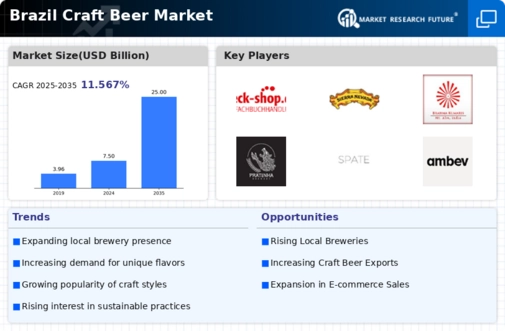Rise of Health-Conscious Choices
The craft beer market in Brazil is adapting to the increasing health consciousness among consumers. As more individuals prioritize their health and wellness, breweries are responding by offering low-calorie and gluten-free options. This shift is reflected in market data, which shows that the sales of low-calorie craft beers have increased by 25% over the past year. By catering to health-conscious consumers, breweries are not only expanding their customer base but also enhancing the overall perception of the craft beer market. This trend suggests that the market may continue to evolve, with an increasing focus on healthier alternatives in the coming years.
Expansion of Distribution Channels
The craft beer market in Brazil is witnessing an expansion of distribution channels. Traditional retail outlets, bars, and restaurants are increasingly featuring craft beers, while online sales platforms are also gaining traction. Recent data suggests that online sales of craft beer have increased by 15% in the past year, indicating a shift in consumer purchasing behavior. This diversification in distribution not only enhances accessibility but also allows smaller breweries to compete more effectively against larger brands. As the craft beer market continues to grow, the expansion of these channels is likely to play a pivotal role in shaping consumer experiences and preferences.
Influence of Social Media Marketing
Social media marketing is becoming a powerful tool for the craft beer market in Brazil. Breweries are leveraging platforms like Instagram and Facebook to engage with consumers, showcase their products, and build brand loyalty. This trend appears to be effective, as data indicates that breweries utilizing social media have seen a 30% increase in customer engagement. The ability to share visually appealing content and interact directly with consumers allows craft breweries to create a community around their products. This engagement not only drives sales but also fosters a deeper connection between consumers and the craft beer market, enhancing brand recognition and loyalty.
Growing Consumer Preference for Quality
The craft beer market in Brazil is shifting notably towards prioritizing quality over quantity. Consumers are increasingly seeking unique flavors and artisanal brewing methods, which has led to a rise in demand for craft beers. This trend is reflected in the market data, indicating that craft beer sales have surged by approximately 20% in the last year alone. As consumers become more discerning, they are willing to pay a premium for high-quality products, which is reshaping the competitive landscape of the craft beer market. This growing preference for quality is not only driving sales but also encouraging breweries to innovate and diversify their offerings, thereby enhancing the overall appeal of the craft beer market in Brazil.
Cultural Significance and Community Engagement
The craft beer market in Brazil is closely connected to local culture and community engagement. Many breweries are emphasizing their connection to local traditions and ingredients, which resonates with consumers seeking authenticity. This cultural significance is evident in the growing popularity of craft beer festivals and events that celebrate local brews. Recent statistics indicate that attendance at craft beer festivals has increased by 40% in the last year, highlighting the community's enthusiasm for local products. This engagement not only strengthens the craft beer market but also fosters a sense of belonging among consumers, further driving interest and sales.






















Leave a Comment